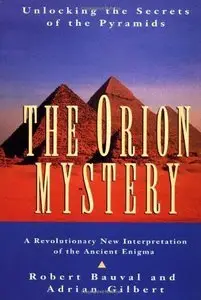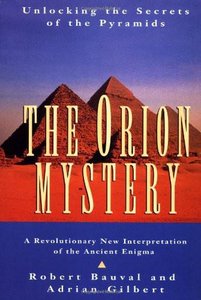Robert Bauval, Adrian Gilbert, "The Orion Mystery: Unlocking the Secrets of the Pyramids"
1995 | ISBN: 0517884542 | EPUB, MOBI | 325 pages | 7 + 7 MB
1995 | ISBN: 0517884542 | EPUB, MOBI | 325 pages | 7 + 7 MB
A revolutionary book that explains the most enigmatic and fascinating wonder of the ancient world: the Pyramids of Egypt. "[An] absorbing and fascinating work of archaeological detection…clearly and rivetingly told…the book is highly and compulsively readable." - London Sunday Times
This fascinating archaeological detective story argues that the great pyramids of Egypt's Fourth Dynasty (c. 26002400 b.c.) were vast astronomically sophisticated temples, rather than the pharaonic tombs depicted by conventional Egyptology. In March 1993, a tiny remote-controlled robot created by Rudolf Gantenbrink, a German robotics engineer, traveled up airshafts within the Great Pyramid of Giza and relayed to scientists video pictures of a hitherto unknown sealed door within the pyramid. Bauval, a British engineer and writer who has been investigating the pyramids for more than ten years, and Gilbert, a British publishing consultant, use Gantenbrink's tantalizing discovery as a launching pad for an extended analysis of the purpose of the mysterious airshafts, which lead from the Great Pyramid's chambers to its exterior, and of the placement of other Fourth Dynasty pyramids. They were sited, the authors argue, to coincide with the key stars of Orion, a constellation that had religious significance for the Egyptians. Bauval and Gilbert claim that the shafts were pointed directly at important stars in Orion–that is, at those stars as they were placed in ancient times. Using astronomical data about stellar movement, they argue that the Orion stars coincide exactly with the pyramids' positions in approximately 10,400 b.c.–a period the Egyptians called the First Time, when they believed the god Osiris ruled the Earth. The authors also speculate that the mysterious space within the Great Pyramid discovered by Gantenbrink contains the mythical Benben stone, which the Egyptians linked to the creation of the world. The book's contentions are sometimes far-fetched and certainly unlikely to put scholarly controversy about the pyramids to rest. Still, this is an enjoyably radical rethinking of the mystery of the pyramids, with some ingenious arguments made in lucid style.



